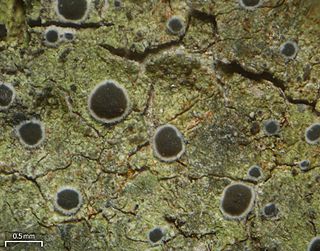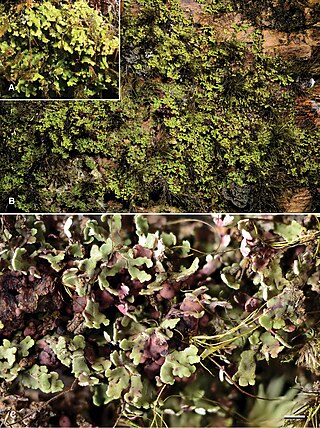
The Peltigeraceae are a family of lichens in the order Peltigerales. The Peltigeraceae, which contains 15 genera and about 600 species, has recently (2018) been emended to include the families Lobariaceae and Nephromataceae. Many Peltigeraceae species have large and conspicuous, leathery thalli. They largely occur in cool-temperate to tropical montane climates. Tripartite thalli involving fungus, green algae and cyanobacteria are common in this family.
Biatorellaceae is a family of lichen-forming fungi in the subclass Lecanoromycetidae. The family is monotypic, and contains the single genus Biatorella, which contains eight species.

The Pilocarpaceae are a family of crustose lichens in the order Lecanorales. The species of this family have a cosmopolitan distribution and have been found in a variety of climatic regions. Pilocarpaceae was circumscribed by Alexander Zahlbruckner in Adolf Engler's influential 1905 work Die Natürlichen Pflanzenfamilien.
Lueckingia is a genus in the family Ramalinaceae. It is a monotypic genus, containing the single corticolous lichen species Lueckingia polyspora. The genus and species were described as new to science in 2006. The species, known only from Costa Rica, was originally found growing on bark in the shaded understory of a lowland rainforest. The genus name honours German lichenologist Robert Lücking (b.1964), who organized the field trip that resulted in the discovery of the new species.

Krogia is a genus of corticolous lichens in the family Ramalinaceae. It occurs in tropical humid forests and rainforests. The genus was circumscribed by Norwegian lichenologist Einar Timdal in 2002, with Krogia coralloides assigned as the type species.

Toniniopsis is a genus of crustose and squamulose lichens in the family Ramalinaceae. The genus was circumscribed by Swiss lichenologist Eduard Frey in 1926, with Toniniopsis obscura designated the type and only species. The genus name of Toniniopsis is in honour of Carlo Tonini (1803–1877), who was an Italian chemist and botanist (Lichenology), who worked in Verona and was a member and President of the Academy of Agriculture. As a result of molecular phylogenetic studies, several species, formerly classified in genus Bacidia, have been transferred to Toniniopsis.
Santessonia is a genus of lichenized fungi in the family Caliciaceae. The genus was circumscribed in 1978 by lichenologists Mason Hale and Gernot Vobis, with Santessonia namibensis assigned as the type species, and at that time, only species. This species, endemic to the Namib Desert, has deep depressions (lacunae) in the thallus, which are interpreted as an adaptation to take advantage of the infrequent moisture provided by fog. The genus name honours Norwegian lichenologist Rolf Santesson.
Minksia is a genus of lichen-forming fungi of uncertain familial placement in the order Arthoniales. The genus was circumscribed by Swiss lichenologist Johannes Müller Argoviensis in 1882 with Minksia caesiella assigned as the type species.
Ingaderia is a genus of lichen-forming fungi in the family Opegraphaceae. The genus was circumscribed by British botanist Otto Vernon Darbishire in 1897.
Bertiella is a genus of fungi in the family Teichosporaceae. although Wijayawardene et al. 2020 places it within the Melanommataceae family.
Caprettia is a genus of lichenized fungi in the family Monoblastiaceae. The genus was circumscribed by Augusto Chaves Batista and Heraldo da Silva Maia in 1965, with Caprettia amazonensis assigned as the type species.

Abrothallus is a genus of lichenicolous fungi. It is the only genus in the monotypic family Abrothallaceae, which itself is the sole taxon in the order Abrothallales.
Clauzadeana is a genus of lichen-forming fungi in the family Lecanoraceae. The genus was circumscribed in 1984 by Claude Roux, with the crustose species C. instratula assigned as the type.

Ramonia is a genus of lichenized fungi in the family Gyalectaceae. It contains 24 species. The genus was circumscribed by Ernst Stizenberger in 1862.
Poeltiaria is a genus of lichen-forming fungi in the family Lecideaceae. It was circumscribed in 1984 by lichenologist Hannes Hertel, with Poeltiaria turgescens assigned as the type species.
Maronea is a genus of lichenized fungi in the family Fuscideaceae.

Brigantiaea is a genus of lichen-forming fungi in the family Brigantiaeaceae. It was circumscribed by Italian botanist Vittore Benedetto Antonio Trevisan de Saint-Léon in 1853.
Otto Follmann was a German geologist, paleontologist and educator.

Bilimbia is a genus of lichen-forming fungi in the family Ramalinaceae.
Pucciniosira is a genus of rust fungi belonging to the family Pucciniosiraceae.







